Mercury is named after the Roman god of commerce, travel, and thievery. In Greek mythology, Mercury was known as Hermes, the messenger of the gods. It probably received this name because it moves very quickly across the sky.
Key Facts & Summary
- Mercury is the closest planet to the Sun at a distance of 57 million kilometers / 35 million miles.
- Out of all the terrestrial planets, Mercury is the smallest. It is also the smallest planet in the Solar System.
- Despite being so small, Mercury is the second-densest planet in the Solar System after Earth. This means it is very compact.
- Mercury does not have any satellites or ring systems.
- The surface of Mercury is similar to the Moon. It is the most heavily cratered planet and this means that it hasn’t been geologically active for many years.
- Mercury has a radius of 2.439 km / 1.516 mi and a diameter of 4.879 km / 3.032 mi.
- Though it is the closest planet to the Sun, temperatures on Mercury are both hot and cold.
- During the day, Mercury’s average surface temperatures can reach up to 800 degrees Fahrenheit / 430 degrees Celsius.
- At night, Mercury’s surface temperatures can drop to as low as -290 degrees Fahrenheit / -180 degrees Celsius.
- Mercury’s changes in temperature are the most drastic in the Solar System.
- Mercury formed around 4.5 billion years ago after gravity pulled swirling gases and dust together.
- After Mercury was formed, scientists believe that it suffered heavy bombardments by comets and asteroids shortly after. Another event called the Late Heavy Bombardment which ended around 3.8 billion years ago, may also be responsible for Mercury’s cratered surface.
- Almost 85% of Mercury’s radius is represented by its enormous iron core.
- Due to the core’s unusual size, Mercury began to shrink as the core cooled and contracted pulling the surface inward.
Mercury is the smallest planet in the Solar System and the closest planet to the Sun. Though it is very close to the Sun, it is not the hottest planet, that title belongs to Venus, but Mercury is the second-hottest nonetheless.
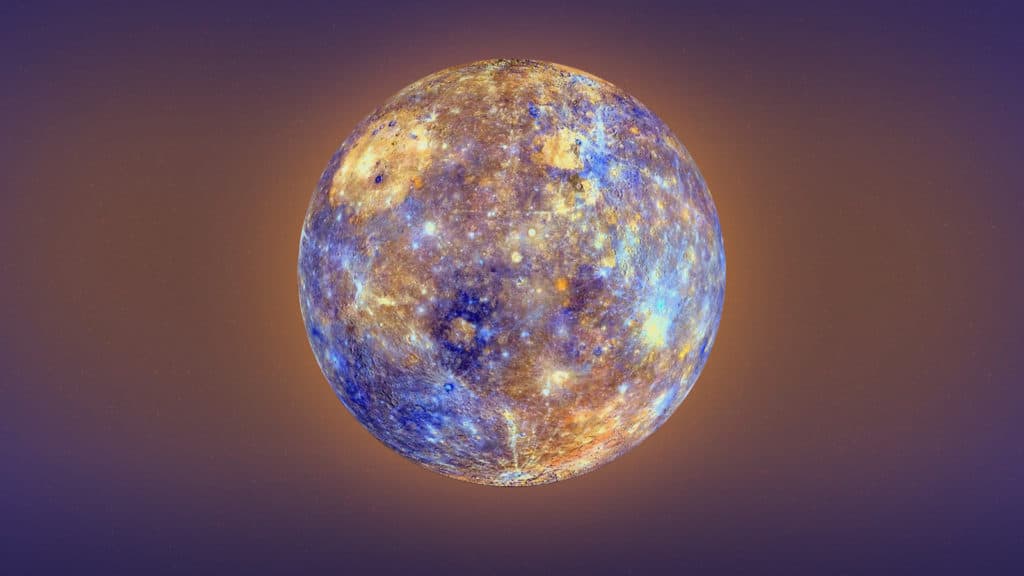
Mercury is slightly bigger than Earth’s Moon, and it is also very similar in appearance to our Moon. Mercury itself doesn’t have any moons. The planet can be seen without binoculars or telescopes, but since it is so near to the Sun, it may be hard to see in the early evening skies.
Surface and structure
Mercury is covered with craters from various impacts. One of the largest is called the Caloris Basin, and it is 1.300 kilometers / 807 miles across.
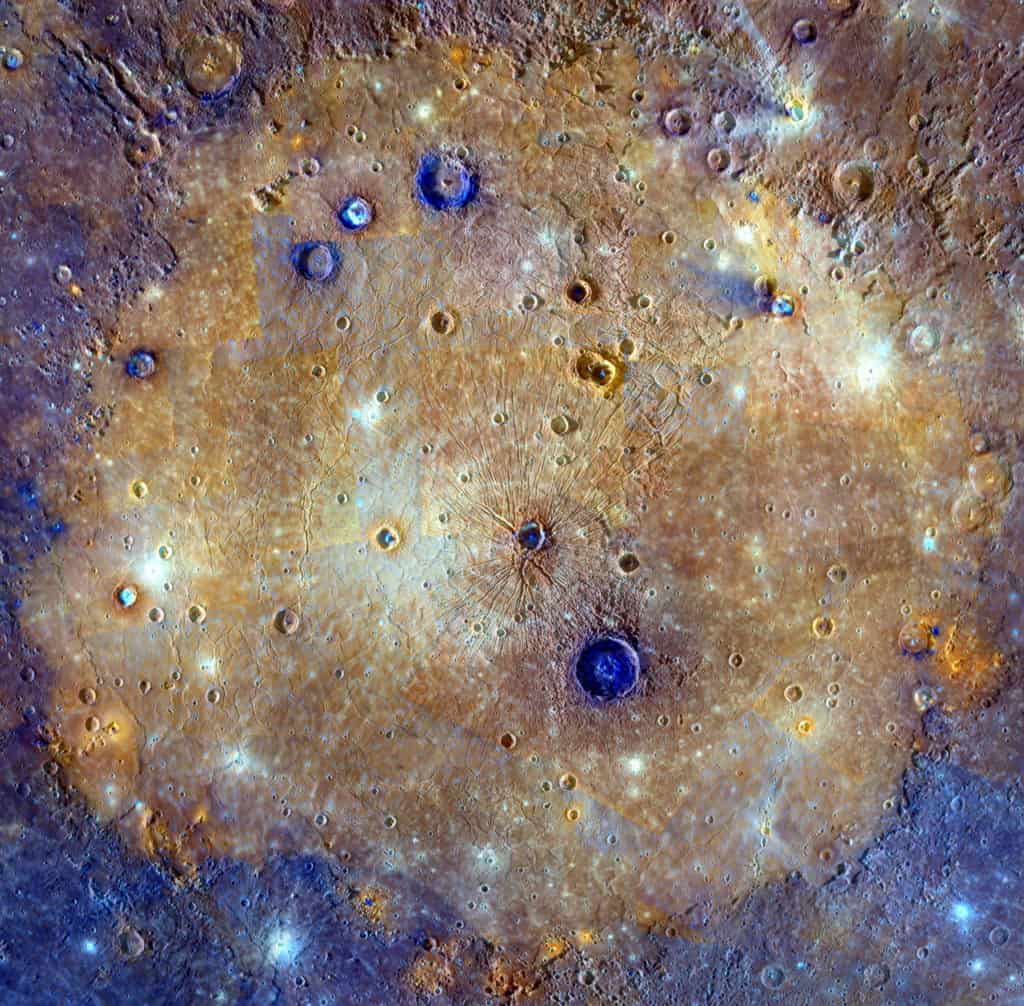
It was probably created by a big impact long ago. Mercury has a very thin atmosphere called an exosphere. It is made out of oxygen, sodium, hydrogen, helium, and potassium.
Since its surface is similar to our Moon, it indicates that the small planet hasn’t been geologically active for many years. The planet is primarily made out of rocks.
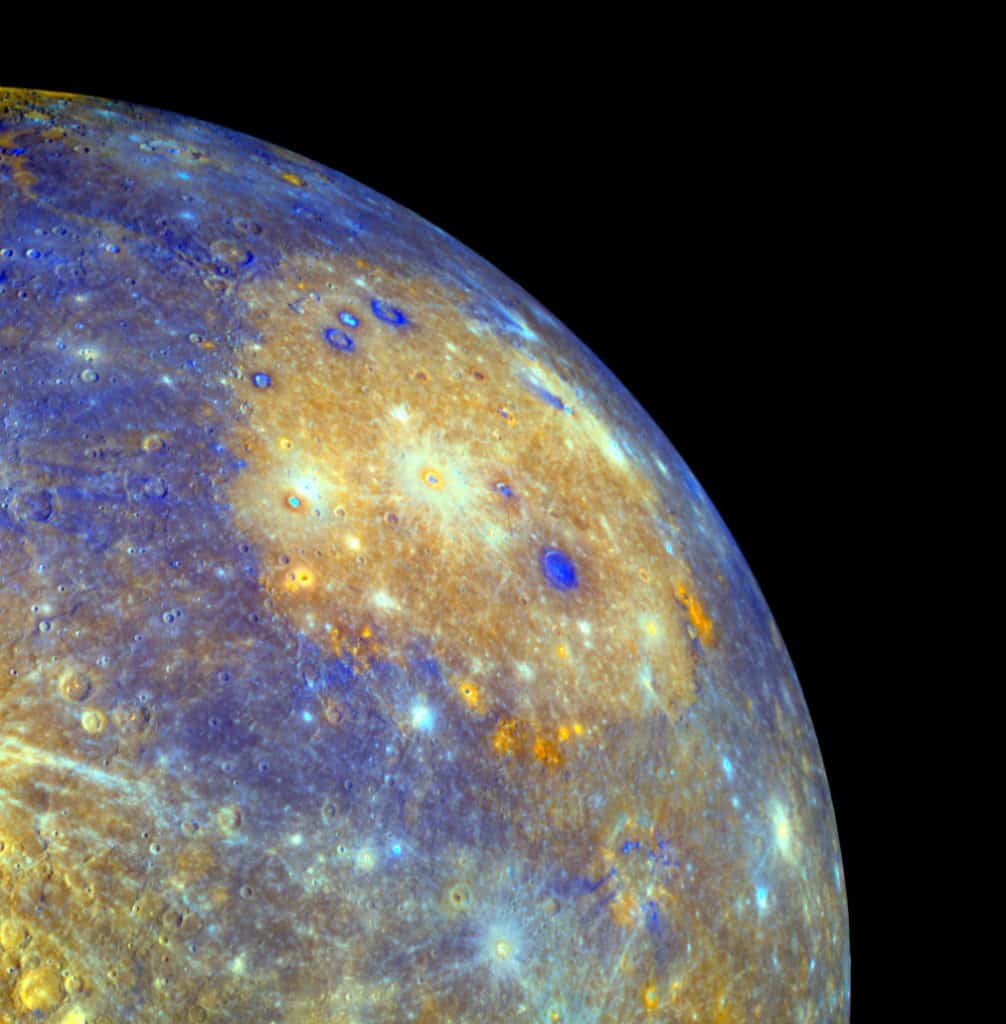
Though it is very hot on Mercury, frozen water exists on its surface. Some of the deep craters present at the poles are never exposed to direct sunlight, and temperatures remain very low there.
Time on Mercury
Mercury spins around slowly compared to Earth. One day on Mercury is 59 Earth days. However, a year on Mercury goes by fast. Because it is close to the Sun, it doesn’t take very long to go all the way around it.
Mercury circles the Sun once every 88 Earth days. If you would live on Mercury, you’d have a birthday every three months! Mercury has the shortest year of any planet. It moves around the Sun with a speed of 47 kilometers / 29 miles per second.
Though on Earth, the Sun rises and sets every day, on Mercury, it takes a long time for this to happen. A sunrise happens on Mercury once every 180 Earth days.
Fun Facts
- In ancient times, Mercury was mistakenly thought of as being two different objects in the sky: The Mourning Star and The Evening Star.
- Mercury orbits the Sun with a speed of around 47 kilometers / 29 miles per second. It is the fastest planet.
- It takes sunlight 3.2 minutes to travel from the Sun to Mercury. If you were on Mercury and the Sun suddenly disappeared, you would notice this only after 3.2 minutes.
- Mercury and Venus orbit the Sun within Earth’s orbit. This makes them inferior planets.
- The crater Caloris Basin on Mercury is large enough to fit the state of Texas.
- NASA has mapped the entire surface of Mercury.
- Mercury’s core has a higher iron content than that of any other major planet in the Solar System.
- Sometimes, Mercury streams particles off of its surface and results in a tail, similar to a comet.
- An event called a “transit” occurs 13 times every century making it possible to see Mercury from Earth, as it crosses the Sun’s face.
Size and Comparison
We know that Mercury is the smallest planet. It has a radius of 2.439 km / 1.516 mi and a diameter of 4.879 km / 3.032 mi. But how does it compare to the other planets in the Solar System?

Both Venus and Earth are around three times bigger than Mercury. Mars is only 30% bigger than Mercury but now let's take a look at the giants of the Solar System.
Neptune and Uranus have more than 10 times the diameter of Mercury. Saturn has 23 times the diameter of Mercury while Jupiter, the biggest planet in the Solar System, has more than 29 times the diameter of Mercury. More than 24.462 Mercury’s would fit inside Jupiter’s volume.
Trivia
Who discovered Mercury?
The naming and discovery of Mercury cannot be attributed to anyone. The ancients knew about Mercury for many years since it is visible with the naked eye.
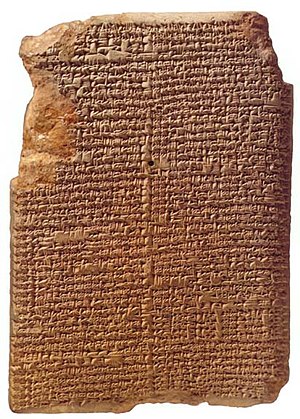
One of the earliest known recorded observations of Mercury is the Mul.Apin tablets. It is believed that these observations were made by an ancient Assyrian astronomer around the 14th century BC. The translation of Mercury’s name written upon those tablets translates to “the jumping planet.”
Planet Nabu
The Babylonians called Mercury, Nabu. Some of their records date back to the 1st millennium BC. Nabu is also the messenger of the gods in Babylonian mythology.
Mercury suffered a great collision
Mercury is theorized to be 4.5 billion years old. Gravity pulled the swirling gas and dust together and formed the small planet. However, Mercury has an enormous core and scientists believe that this is the result of a collision. Another giant object smashed into Mercury and stripped much of its surface.
Other Characteristics
Though Venus is the closest planet to Earth, it spends most of its time far away. This makes Mercury the nearest planet to Earth, at least for certain periods. Since Mercury has a thin atmosphere, temperatures at night drop very low, from 430 degrees Celsius during the day, to -180 degrees Celsius at night.

Mercury doesn’t have any moons, and since it is very close to the Sun, it will never have. The Sun will basically steal any satellite of Mercury.
The core of Mercury has high amounts of iron, more so than any major planet in the Solar System. NASA has mapped the entire surface of Mercury, and yes, it is the most cratered planet in the Solar System.
Since Mercury is close to us, we can easily send spacecraft or probes to it. The third spacecraft set to arrive on Mercury is named BepiColombo, and it should arrive at Mercury in 2025.
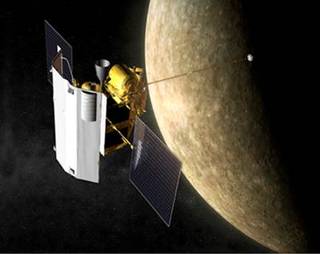
Mercury Notes
- Mercury is the closest planet to the Sun, but not the hottest.
- It is the smallest planet in the Solar System, it doesn’t experience any seasons, temperatures drastically change during day and night because it has a thin atmosphere, and it is the most heavily cratered planet.
- Mercury doesn’t have a moon, and since it is so close to the Sun, it will never have a moon.
- Mercury is about twice as large as Pluto, and it would take 18 Mercury’s to match Earth’s size.
- The first spacecraft to explore Mercury was NASA’s Mariner 10, it happened in 1974.
- If you were on Mercury, the Sun would appear three times as large in the sky as it does when viewed from Earth. The sunlight, however, would be seven times more powerful.
- Mercury’s core which pulled its surface inward due to contraction is believed to have reduced the planet’s size between 1 – 7 km / 4 mi.
Sources:
[1.] Wikipedia
[2.] NASA
Image sources:
- https://solarsystem.nasa.gov/system/stellar_items/image_files/2_feature_1600x900_mercury.jpg
- https://solarsystem.nasa.gov/system/resources/detail_files/2266_PIA19216_1280.jpg
- https://upload.wikimedia.org/wikipedia/commons/thumb/4/41/Mulapin.jpg/300px-Mulapin.jpg
- https://cdn.mos.cms.futurecdn.net/rCdTVsPesASiv3JeVyhHsa-1200-80.jpg
- https://apod.nasa.gov/apod/image/0807/caloris_messenger_falsecolor.jpg
- https://solarsystem.nasa.gov/system/stellar_items/list_view_images/2_mercury_480x320_new.jpg
- https://www.nasa.gov/sites/default/files/styles/side_image/public/thumbnails/image/edu_messenger_planet_mercury.jpg?itok=ctRZHEh-
